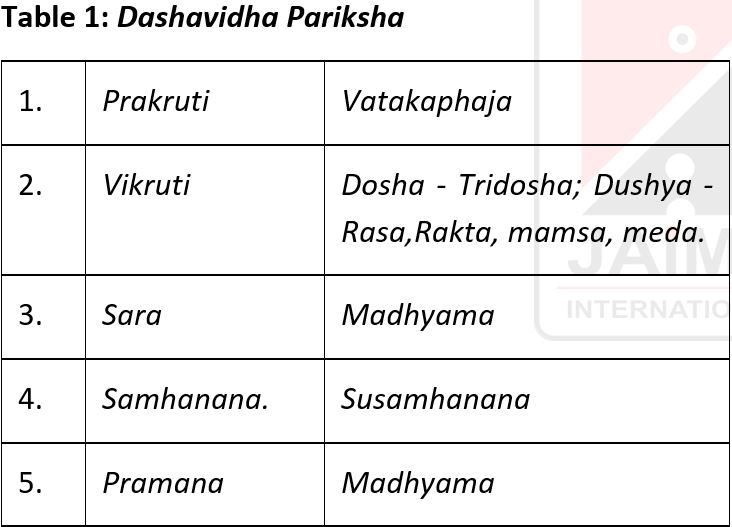An Integrated approach towards Type 2 Diabetes Mellitus - A Case Report
DOI:
https://doi.org/10.21760/jaims.10.7.44Keywords:
Diabetes mellitus, HbA1c, Ayurveda, Hyperglycemia, Hypoglycemia, Type 1 diabetes, Type 2 diabetes, Gestational diabetesAbstract
Introduction: "Sitting is the new smoking" asserts that leading a sedentary lifestyle can have serious negative consequences because of the rising incidence and poor prognosis, metabolic diseases are a concern for society. In situations where the expected treatment does not yield the anticipated results, this case illustrates how the Ayurvedic approach to management can yield flawless results. Clinical Findings: A 58-year-old man has had low back pain, burning soles, dizziness, and generalized weakness for three years. Diagnosis: A pre-diagnosed case of Type 2 Diabetes Mellitus who took high dosages of various anti-diabetic drugs for seven years. Intervention: Following a suitable Ayurvedic evaluation of the patient, a combination of Shamana treatment and allopathic drugs, as well as recommendations for dietary and lifestyle changes, were administered. Outcome: The result was a significant decrease in the dosage of his allopathic medication, as well as a reduction of his symptoms and HbA1c values. Conclusion: The quality of life can be improved by implementing and modifying an Ayurvedic approach to managing Type 2 Diabetes mellitus, which can significantly reduce the need for allopathic medicine and its symptoms.
Downloads
References
Kumar A, Gangwar R, Zargar AA, Kumar R, Sharma A. Prevalence of diabetes in India: a review of IDF Diabetes Atlas 10th edition. Curr Diabetes Rev. 2024;20(1):105–14.
Kahn CR. Banting Lecture. Insulin action, diabetogenes, and the cause of type II diabetes. Diabetes. 1994;43(8):1066–84.
World Health Organization. Diabetes. Factsheet [Internet]. Geneva: WHO; 2012 [updated 2013 Mar; cited 2013 Jun 8]. Available from: http://www.who.int/mediacentre/factsheets/fs312/en/index.html
Bharti SK, Krishnan S, Kumar A, Kumar A. Antidiabetic phytoconstituents and their mode of action on metabolic pathways. Ther Adv Endocrinol Metab. 2018 Mar;9(3):81–100. doi: 10.1177/2042018818755019. PMID: 29492244; PMCID: PMC5813859.
Charaka Samhita of Agnivesha revised by Charaka and Dridhabala. Sutrasthana, Trishotiya Adhaya 18/44 [Internet]. Available from: http://niimh.nic.in/ebooks/echarak
Bhattacharya SK. Shilajit attenuates streptozotocin-induced DM and decrease in pancreatic islet superoxide dismutase activity in rats. Phytother Res. 1995;9:41–4.
Bhattacharya SK, Sen AP. Effect of shilajit on biogenic free radicals. Phytother Res. 1995;9:56–9.
Ghosal S, Soumya L, Kumar Y. Interaction of Shilajit with biogenic free radicals. Indian J Chem. 1995;34B:596–602.
Trivedi NA, Mazumdar B, Bhatt JD, Hemavathi KG. Effect of shilajit on blood glucose and lipid profile in alloxan-induced diabetic rats. Indian J Pharmacol. 2004;36(6):373–6.
Sekar BC, Mukherjee B, Chakravarti RB, Mukherjee SK. Effect of different fractions of Swertia chirayita on the blood sugar level of albino rats. J Ethnopharmacol. 1987;21(2):175–81.
Aligita W, Susilawati E, Septiani H, Atsil R. Antidiabetic activity of coriander (Coriandrum sativum L) leaves’ ethanolic extract. Int J Pharm Pharmacol Res. 2018;8(2):59–63.
Sharma B, Salunke R, Srivastava S, Majumder C, Roy P. Effects of guggulsterone isolated from Commiphora mukul in high fat diet-induced diabetic rats. Food Chem Toxicol. 2009;47(10):2631–9. doi:10.1016/j.fct.2009.07.021.















